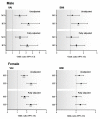Use of the Visceral Adiposity Index as an Indicator of Chronic Kidney Disease in Older Adults: Comparison with Body Mass Index
- PMID: 36362525
- PMCID: PMC9659218
- DOI: 10.3390/jcm11216297
Use of the Visceral Adiposity Index as an Indicator of Chronic Kidney Disease in Older Adults: Comparison with Body Mass Index
Abstract
The visceral adiposity index (VAI) was recently introduced to quantify visceral fat accumulation and dysfunction. This cross-sectional study explored whether the VAI is associated with chronic kidney disease (CKD) in older adults and compared its utility with that of body mass index (BMI) for predicting CKD. In total, 7736 older adults (3479 men and 4257 women) aged ≥ 60 years were divided into normal, mild, and moderate-to-severe CKD groups. Associations of the VAI and BMI with CKD were compared among the groups, and cut-off points for moderate-to-severe CKD (MSCKD) were established. While the VAI could discriminate among all of the groups, the BMI could not. The severity of CKD was more strongly associated with the VAI than BMI. The odds ratios indicated that, in the fully adjusted model, the VAI was a significant predictor of MSCKD in both men and women, while the BMI was a significant predictor only in men. For the VAI, the area under the receiver operating characteristic curve values for men and women were 0.631 (cut-off point: ≥2.993) and 0.588 (≥4.001), compared with 0.555 (≥25.335) and 0.533 (≥24.096) for BMI, respectively. Taken together, the findings suggest that the VAI is associated with CKD and represents a better indicator for the disease than BMI.
Keywords: body mass index; chronic kidney disease; older adults; visceral adiposity index.
Conflict of interest statement
The authors declare no conflict of interest.
Figures




References
Grants and funding
LinkOut - more resources
Full Text Sources

